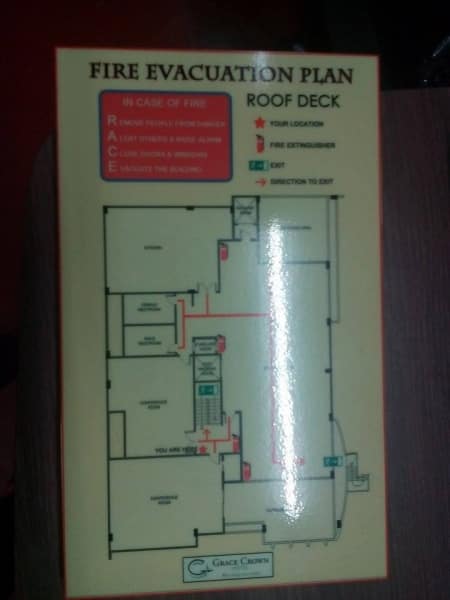Safety Signs & Photoluminescent Signage
Safety Signs are a must. Most people have seen safety signage anywhere they go, and people take heed without really seeing them. They take it for granted because it is something they expect in any commercial building, on the road, and in any public place. This is called sign blindness, and while this may be acceptable in the general run of things, it is not acceptable in the workplace. You need a good sign maker to make the signs prominent and noticeable in order to be effective. One way to do that is to make it glow in the dark.
Many road signs glow in the dark because they need to be visible at night, and most safety signs in malls and commercial buildings are also glow in the dark, although they are less apparent. A photoluminescent sign only becomes obvious when the lights are off, and most people are out the mall when the lights go out. However, in the workplace, a photoluminescent sign can save lives when they are placed in the proper areas.
What is important to note is that safety signage are important tools for communication. They warn people in symbol fashion about any potential dangers of risk in any situation, especially in the workplace. Most governments require the use of a photo luminescent sign in all areas in the worksite that poses a danger to workers and visitors alike. A simple slippery when wet sign can spell the difference between a costly personal injury lawsuit and no liability for a company.
Aside from warning people of safety hazards, safety signage in the workplace increases awareness of workers, making them more cautious when going about their business. Safety signs also increases awareness of the public in commercial areas, roads, and other public facilities such as sidewalks and parks. Safety signs can help reduce accidents and injury in any situation.
Safety signage is not the same everywhere. Some industries have special requirements when handling equipment or chemicals. The health industry, for example, may need biohazard signs while the energy industry would need electrical safety signs, both types of which you would probably not see in an office building or the mall. However, some standards are almost universal.


Standards for safety signage
The best types of safety signs are those that cut across language barriers. They use universally recognized symbols and colors to signify certain meanings that anyone can understand. The purpose of safety signs, after all, is to ensure the safety of everyone.
Shapes
Workplace signs usually come in four shapes. Each one means something specific.
Triangle – this typically indicates “caution” for a potential danger, or a warning for definite danger. A good example is a triangle on an electrical panel, which means a definite danger of electric shock.
Circle – this typically denotes an action that should or must be done for safety, such as wearing a hard hat. A circle with a diagonal slash across it means an action to be avoided, such as walking in certain areas
Square and rectangles – indicates general information about an area, such as a telephone symbol to indicate the presences of an emergency call box
Colors
Colors are also important to indicate the type of danger and urgency.
Red – indicates the location of emergency tools or devices such as fire hoses; it also indicates any action that could put a person in danger, such as smoking or lighting a match in the vicinity of a flammable source
Yellow – indicates the need for caution and alertness for potential dangers to reduce risk of injury
Blue – indicates the need to perform a particular action for safety, such as wearing safety gloves
Green – indicates the location of an emergency facility or tools, such as fire exits or evacuation routes
While these standards may apply internationally, not everybody actually understands what the signs mean or how they should react to this. In the workplace, it is important to orient employees about the meaning of the different signs, but the public would not have that kind of orientation to help them understand the meaning of these shapes and colors.
Even if the shapes and colors are enough to indicate danger or warning, it is not enough to simply warn of danger. These signs should have specific or detailed descriptions of the type of danger, risk, or action required, and preferably reiterated at strategic intervals. Some signs also go together, such as a danger sign accompanied by an instruction sign. This ensures that people are aware of the danger and know what to do about it. A good sign maker would therefore add universally understood symbols to help people avoid dangers and risks, as well as increases awareness of safety precautions. Having the appropriate safety signs in the workplace and any other place where people gather or stay is important to ensure their safety.
Types of safety signage and photoluminescent sign
Biohazard
Handling chemicals is common in many industrial workplaces and health industries. Many of these chemicals are dangerous in themselves, or the processing of them poses a health risk to any person in the area. Each of these hazardous chemicals or materials are indicated by a standard symbol called a biohazard, and some safety signs may indicate when a material has a toxic effect, cause burns, are flammable, or pose a risk of explosion. These signs are there to warn people to be very careful around these substances.
Biohazard
Some biohazard facts
The symbol for biohazards is quite distinctive, and it is believed that National Institutes of Health’s Robert S. Runkle and Dow Chemicals’s Charles L. Baldwin developed it back in 1966. A NIH monograph published in 1978 provided a technical diagram and discussion of the symbol:
“A biological hazard symbol is used internationally to indicate the actual or potential presence of a biohazard and to identify equipment, containers, rooms, materials, experimental animals or combinations thereof can be obtained commercially and placed upon a placard that is large enough for the symbol together with other appropriate information. The term “biohazard” for the purpose of this symbol is defined as “those infectious agents presenting a risk or potential risk to the well-being of man, either directly through his infection or indirectly through disruption of his environment.”
As part of its technical specifications, the biohazard sign always has a background of high contrast. It may be a photo luminescent sign in orange, or a flat orange-red color, although it may also be other colors. This throws the symbol itself into sharp relief, making it unmistakable and noticeable in any size and location.
In use, the biohazard signifies the potential or actual risk of a biological nature. The sign may be accompanied by another symbol or text to specify the identity or nature of the dangerous substance, the person or entity responsible for the control of the substance, or instructions on how to handle the material. In no case should these additional information obscure or be superimposed on the biohazard symbol itself.
The biohazard symbol may also be used for biological matter in hospitals and other health institutions, such as tissue, blood, or other medical waste that may contain toxins or other contaminants such as a virus or bacteria that may infect other people on contact or exposure. People who venture into areas where biological materials are present should take the necessary precautions, such as wearing protective clothing, gloves, or masks.
Caution
The caution signanother safety signs is also called a warning sign, and it is there to inform people that there are potential hazards or dangers in the area. This is typically a yellow colored triangle with a large exclamation mark, which most people recognize enough to give them pause. The background may also be orange-yellow or white, but the exclamation mark is always present.
Some jurisdictions may have regulations in place for the standard colors and features of a caution sign. For example, the American National Standards Institute or ANSI decrees that the background color of a caution sign will be yellow, with the text in black, and that the actual colors will be based on the samples specified in Table 1 of ANSI Z535.1-2006(R2011) or ANSI Z53.1-1967.
Danger
The danger sign is probably even more recognizable than the triangle yellow caution sign. Typically, danger signs use red and black colors to indicate a life-threatening situation. It could be deep waters, hazardous chemicals or machines, or perhaps dangerous terrain. In many cases, the word “Danger” is placed inside a red oval inside a black rectangle. The specific danger may be added below in text, or a symbol such as a skull and crossbones.
In some instances, danger signs are triangular with the word “danger” followed by a specific danger, such as falling debris or a thunderbolt, indicating a shock hazard.
Electrical safety
Electrical safety signs are also referred to as the high voltage sign, and typically include a graphical representation of electricity using a zigzag arrow, or an electrical wire with a plug. This warns people that the possibility of electrical shock is present. This type of sign usually has bold backgrounds. Some signs may indicate buried cables (an arrow pointed downward) or the risk of static charge (a lightning bolt on the bottom of a shoe) that could cause an explosion, such as in a gas station. Many electrical outlets and panels will also have these types of safety signage.
You may sometimes find a square sign with a green cross, which indicates the location of a first aid station, while a red cross would indicate an ambulance service in the area.
Notice signs

Notice signs are typically text heavy signs designed to provide instructions for workers on what to do to do their job safely. These are usually square or rectangular signs with the word “Notice” in white against a blue background, which in turn is superimposed on a white background. In some cases, the notice sign warns people about the need for safety precautions, such as earplugs to protect them from loud noises, such as at a drill site. In other cases, it could inform people they are approaching a specific area where they may be subject to inspection, such as a security checkpoint, or the presence of recording equipment.
Directional signs
While not all directional signs qualify as safety signs, some do. These include emergency exit signs and arrows, which are usually photo luminescent signs, and evacuation plans that show the location and direction of emergency exits on each floor in case of fire and other types of emergencies. Companies and building administrators often conduct fire drills to educate workers and building occupants on the use of these directional signs and evacuation process.
Road signs
The road is a hazardous place, which is why most roads have signs every few feet. It could be the speed limits, road curves, blind corners, hill ahead. or debris falling. Some signs indicate when an area is a common hazard for car accidents, slippery when wet, or when there is a sheer drop on the next bend. In other cases, you will see a sign indicating a road narrowing, or where overtaking is not allowed. Some signs indicate one-way streets, two-way traffic, no left or no right turns, and no U-turns. Other important road signs include the stop sign, yield sign, merging traffic, railroad crossing, pedestrian crossing, roadwork, and school zones.
Conclusion
In most cases, safety signs and, in some instances, a photoluminescent sign, may be in a certain area in compliance with laws or regulations. It is in the best interest of employers, building owners, and public officials to ensure that these signs are present to warn people about potential dangers or risks. Failing to provide these signs as appropriate can make them liable for any injuries or harm. While these signs are only as good as other safety measures in place, they serve an important function: communicating the presence of danger and raising awareness in people of the potential risks to their health and safety.






